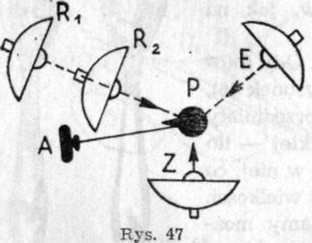With any lighting system, realized with one or more light sources, one of them is the principal light, it's light, which is designed to model the surface and spatiality of the object, which gives the picture character.
Relatively rarely, a single light source gives the photographer complete freedom to achieve the intended lighting. Then he uses additional light sources, like light bulbs, flash lamps, sometimes sunlight too, and various types of devices, reflecting light, like mirrors, tin foils, paper screens, or other.
As we know, in some cases, increasing the number of light sources eliminates the top lights; however, the conscious and rational use of additional light sources makes it possible to obtain results unattainable with a single headlamp.
 Additional light sources can play two roles depending on their location relative to the axis AP - camera - object (drawing 47, AP). When, for example,. Z is the primary light source, it will not illuminate the luminosity of the shadowed part of the object. To get on it, albeit dark, but visible details, we use a weaker R1 or R2 illuminating light source, or placed farther from the item than Z. Most often we place them near the AP, at least in the space between the camera and the object, R2 less often outside the camera (R1). This light illuminates a large part of the object's surface as seen by the camera. It also illuminates part of the surface of the object, illuminated by the main light. The illuminating light is added to the main light. Therefore, with such an arrangement, there must be a difference in the brightness of both these parts of the surface.
Additional light sources can play two roles depending on their location relative to the axis AP - camera - object (drawing 47, AP). When, for example,. Z is the primary light source, it will not illuminate the luminosity of the shadowed part of the object. To get on it, albeit dark, but visible details, we use a weaker R1 or R2 illuminating light source, or placed farther from the item than Z. Most often we place them near the AP, at least in the space between the camera and the object, R2 less often outside the camera (R1). This light illuminates a large part of the object's surface as seen by the camera. It also illuminates part of the surface of the object, illuminated by the main light. The illuminating light is added to the main light. Therefore, with such an arrangement, there must be a difference in the brightness of both these parts of the surface.
The second type of additional light is effect light. We basically put them outside of the object (drawing 47, E). It illuminates a small part of the surface of the object seen by the camera and is usually the brightest part of its surface. Effect lighting enhances the tonality of the image, increasing the impression of spatiality of the object to some extent.
Overhead lighting can play the role of illuminating and effective. It is most often used in a portrait to lighten the model's hair tone. In other cases, rarely seen.